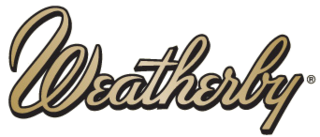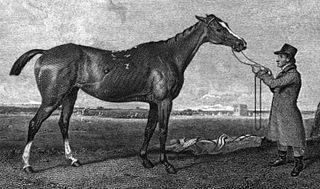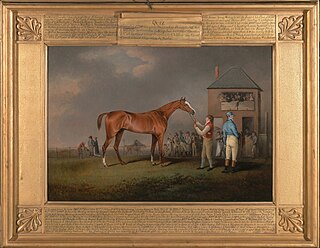
A double-barreled shotgun, also known as a double shotgun, is a break-action shotgun with two parallel barrels, allowing two single shots that can be fired simultaneously or sequentially in quick succession.

Area 51 is a light gun arcade game released by Atari Games in 1995. It takes its name from the military facility. The plot of the game involves the player taking part in a Strategic Tactical Advanced Alien Response (STAAR) military incursion to prevent aliens, known as the Kronn, and alien-created zombies from taking over the Area 51 military facility.

Weatherby, Inc. is an American gun manufacturer founded in 1945 by Roy Weatherby. The company is best known for its high-powered magnum cartridges, such as the .257 Weatherby Magnum, .270 Weatherby Magnum, .300 Weatherby Magnum, .340 Weatherby Magnum and the .460 Weatherby Magnum. The company's headquarters is in Sheridan, Wyoming.

An elephant gun is a large caliber gun, rifled or smoothbore, originally developed for use by big-game hunters for elephant and other large game. Elephant guns were black powder muzzle-loaders at first, then black powder express rifles, then later used smokeless powder cartridges.
The Weatherbys Group is a UK conglomerate involved in a wide range of activities largely within banking and horse racing. The original business was founded by James Weatherby in 1770.

The Ruger No. 1 is a single-shot rifle with a Farquharson-style hammerless falling-block action, introduced and manufactured by Sturm, Ruger & Co. since 1967. An underlever lowers the breechblock to allow ammunition loading and also cocks the rifle. Lenard Brownell, commenting on his work at Ruger, said of the No. 1: "There was never any question about the strength of the action. I remember, in testing it, how much trouble I had trying to tear it up. In fact, I never did manage to blow one apart."
Roy Edward Weatherby, was the founder and owner of Weatherby, Inc., an American rifle, shotgun and cartridge manufacturing company founded 1945. Weatherby created an entire line of custom cartridges, and was one of the people responsible for the industry interest in high-speed cartridges. He created a custom rifle action to accommodate his high-pressure cartridges.

The .340 Weatherby Magnum rifle cartridge was introduced in 1962 by creator Roy Weatherby to fill the gap between the .300 Weatherby Magnum and the .378 Weatherby Magnum, and in response to the .338 Winchester Magnum released in 1958.
The Weatherby Mark V is a centerfire, bolt-action rifle manufactured by Weatherby of Sheridan, Wyoming. The rifle was introduced in 1957 by Weatherby and was designed to safely contain the high pressures associated with the Weatherby line of high performance cartridges. It is the flagship rifle of the Weatherby line of firearms.
The Weatherby PA-08 is a 12 gauge 3 in (76 mm) pump action shotgun marketed by Weatherby Inc. The shotgun is economically priced and constitutes the low end of products marketed by Weatherby. The PA-08 is manufactured in Turkey for Weatherby.
The Weatherby SA-08 is a semi-automatic shotgun marketed by Weatherby Inc. The shotgun is available in either 12 or 20 gauge. Like the Weatherby PA-08 pump-action shotgun, this shotgun constitutes Weatherby's low-end shotgun line. The SA-08 is manufactured in Turkey for Weatherby. This semi-automatic uses a dual valve system which require to be manually changed out when moving from light to heavy loads and vice versa.

Cardinal Beaufort was a Thoroughbred racehorse that won the 1805 Epsom Derby. Cardinal Beaufort raced until he was six-years-old, winning eight races before his death in late 1808. Cardinal Beaufort was bred by the Earl of Egremont who raced him during his early career. Cardinal Beaufort was sold frequently in his later racing career, changing hands seven times in the last two years of his life.

Whisker was a Thoroughbred racehorse that won the 1815 Epsom Derby and was a full-brother of the 1810 winner Whalebone. Whisker raced until he was a six-year-old, but did not race in 1817. Whisker was retired to stud in 1819, where he became a successful and influential sire. The offspring of Whisker and Whalebone continued the sire-line of Eclipse into the 20th century.

Formosa (1865–1881) was a British Thoroughbred racehorse that was the first winner of the English Fillies Triple Crown in addition to running a dead heat with the colt Moslem for the 2,000 Guineas Stakes. Formosa was bred by James Cookson and was foaled in 1865 at his Neasham Hall stud farm. Formosa was sold to William Graham in 1866 and raced her entire three-year racing career under his ownership. After her racing career ended in 1871, she became a broodmare for Graham until his death in 1876. Formosa was exported to France in 1879 and died there in February 1881. While she did not produce offspring that excelled at racing, her daughters that were exported to Germany and New Zealand did produce descendants that were successful racers.

Rhoda was a British Thoroughbred racehorse and broodmare who won the third running of the classic 1000 Guineas at Newmarket Racecourse in 1816 and was the most successful racehorse in Britain two years later. Rhoda was one of the most active of all British classic winners, running in at least forty-five contests between 1816 and 1820 and winning twenty-one times. Her actual number of competitive races was even higher as many of her later races were run in multiple heats, with the prize going to the first horse to win twice. She won the 1000 Guineas on her second appearance but did not run as a three-year-old after finishing unplaced in the Oaks Stakes. Rhoda won three races in 1817, ten in 1818, four in 1819 and two in 1820.

Meteora (1802–1821) was a British Thoroughbred racehorse and broodmare who won the classic Oaks Stakes at Epsom Downs Racecourse in 1805. In a racing career which began with her win in the Oaks on 31 May 1805 and lasted until July 1810 she ran thirty-six timeas and won twenty-four races. She defeated the Derby winner Cardinal Beaufort and the St Leger winner Staveley in match races and won many other important races of the era including the Stamford Gold Cup, the Oatlands Stakes (twice), the Audley End Stakes, the Somerset Stakes and the Brighton Gold Cup. Many of her defeats occurred when she was carrying large weights in handicap races.
Sorcery was a British Thoroughbred racehorse and broodmare who won the classic Oaks Stakes at Epsom Downs Racecourse in 1811. In a racing career which lasted from April 1811 to July 1814 the filly ran twenty-six times, winning twelve races and finishing placed on eleven occasions. Sorcery won the Oaks on her third racecourse appearance and went on to win other important races including the Epsom Gold Cup, the Trial Stakes, two editions of the Oatlands Stakes, a King's Plate and several match races. After her retirement from racing she became a successful broodmare, being the dam of the 1828 Epsom Derby winner Cadland.

Quiz (1798–1826) was a British Thoroughbred racehorse and sire best known for winning the classic St Leger Stakes in 1801. Quiz was a durable, top-class performer, winning at least once a year in racing career which lasted seven seasons from August 1801 until April 1807. Apart from the St Leger he won many other important races including three Brocket Hall Gold Cups, two Oatlands Stakes at Newmarket Racecourse, a Great Subscription Purse at York, a King's Plate and the Jockey Club Plate. In all he won twenty-one times in thirty-six races for four different owners before being retired to stud, one of which was Mr Hallett Esq, where he proved to be a successful sire of winners.
Young Traveller was a British Thoroughbred racehorse best known for winning the classic St Leger Stakes in 1791. Bred and originally campaigned in Yorkshire he won two of his three races as an unnamed three-year-old in 1791. On the day after his classic victory he defeated an unusually strong field of older horse to become the first St Leger winner to also win the Doncaster Cup. In the following year he was sold, renamed and raced mainly in Scotland, winning a further five races before the end of his racing career. Young Traveller does not appear to have been used as a breeding stallion.
Cwrw was a British Thoroughbred racehorse and sire and best known for winning the classic 2000 Guineas in 1812. In a racing career which lasted from April 1812 until September 1816 he won six of his twenty-six races. He won the 2000 Guineas on his racing debut in a race which led indirectly to a change in the betting rules in the United Kingdom. Cwrw won his two other races in 1812, but the rest of his career was relatively undistinguished. He passed through the hands of various owners winning once in 1813, once in 1814 and once in 1816. He was retired from racing and exported to stand as a breeding stallion in South Africa. Cwrw is the Welsh word for beer.











